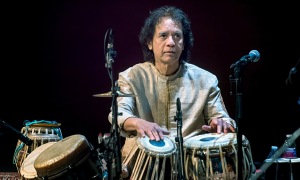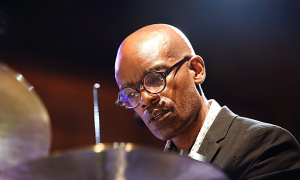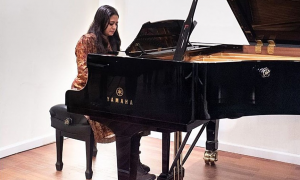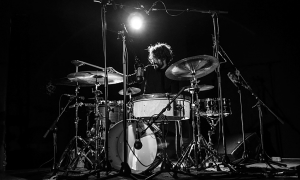Home » Jazz Articles » Under the Radar » Preserving the Cradle of Jazz: The New Orleans Jazz Museum
Preserving the Cradle of Jazz: The New Orleans Jazz Museum

Whereas New York has a jazz industry, New Orleans has a jazz culture
—Quint Davis
As of their 1951 newsletter—The Second Line—the club was charging an annual membership fee of two dollars. The publication focused on promoting jazz and dance hall venues, posting jazz recommendations and artist interviews. The magazine's following pulled in advertising dollars from record stores as far away as Philadelphia, PA. A 1950 issue of the newsletter indicates a formality and sophistication in the intent of the club. The club's then-president was a physician named Edmond Souchon who shared a quote from the organization's Preamble to the Constitution, stating that the purpose for founding the club was "To afford a common meeting ground for lovers of Jazz. To preserve, stimulate, encourage and retain New Orleans jazz, primarily...." Fifty-three years later, the club and the newsletter were still intact and taking on topics such as the direct impact of Hurricane Katrina on the NOLA jazz scene, but in those early years, members offered to share their own collectible memorabilia, and records, books and photographs, giving the club an alternate function as a kind of miniature, members-only museum. That concept appears to have fostered a more formal blueprint for a museum though it was 1961 before that plan was realized.
The Original New Orleans Jazz Museum
The personal possessions of those New Orleans Jazz Club members became the archival foundation of the New Orleans Jazz Museum when it opened on in the French Quartet on Dumaine Street in 1961. The Museum's first director, Henry Clay Watson, wore multiple hats in designing, curating and documenting the burgeoning collections. The bugle and case on which Louis Armstrong learned to play in 1913, and other instruments dating back to the Dixieland era, were among the prized exhibits. There are a number of similarities in the history and circumstances between the New Orleans museum and the first New York Jazz Museum. Watson, like Howard Fisher, the New York director, was not considered a well-seasoned jazz aficionado. In his book Collected Works: A Journal of Jazz 1954-2000 (St. Martin's Press, 2000), journalist Whitney Balliett quotes Red Allen—a New Orleans trumpeter who once played with King Oliver and Louis Armstrong—describing Watson as someone who ..."may not know much about jazz..." By the time the museum had relocated to The Royal Sonesta Hotel in 1969, it had churned through a number of directors. Again, like its New York counterpart, the museum had a difficult time holding down a location and in the early 1970s moved to Conti Street. The same economic recession that had crippled New York was taking its toll on New Orleans and in 1977 the museum's collection was transferred to the Louisiana State Museum and their doors closed.
The New Orleans Jazz Museum, Reborn
The collections that had been retained at the Louisiana State Museum were moved to the Old US Mint on 400 Esplanade St. in 1982 only to be returned to storage after that facility was damaged by Hurricane Katrina in 2005. The renovations led to a reopening in 2011, now including a state-of-the-art performance facility. Greg Lambousy is Director of New Orleans Jazz Museum (NOJM) and he provided detailed insights regarding the museum's current state and future goals. Lambousy says of the NOJM, that the organization ..."celebrates the history of jazz, in all its forms, through dynamic interactive exhibits, multigenerational educational programming, research facilities and engaging musical performances. The NOJM enhances New Orleans' ongoing cultural renaissance by providing diverse resources for musicians and music lovers of all languages and nationalities. We fully explore America's quintessential musical art form, in the city where jazz was born."
The collections housed in NOJM are largely linked to that city's jazz artists and venues, as are most of the exhibits, but genres outside jazz are not forgotten in this eclectic city. Lambousy adds that, "We host a wide range of performances and within our Music at the Mint series we regularly invite artists from other countries to perform. It is safe to say that New Orleans is one of the leading international cities for music. It's an organic development that is continuing to be fueled by tradition, and musicians from elsewhere seeking the city's easy lifestyle. We do our part in supporting and reflecting that global perspective in our music programming. We always attempt to provide information to our visitors that they might not otherwise come in contact [with] in general media coverage. It's not that difficult to do when the collection is used as a starting point. This applies to most of our exhibits and programs."
One of the premier exhibits at NOJM is Satchmo: His Life in New Orleans, a unique collaboration between New York's Louis Armstrong House Museum and the Louisiana State Museum. From 1943 until Armstrong's death in 1971, the Armstrong House was the trumpeter's home, and his wife, Lucille Wilson, donated the residence to New York City for the express purpose of creating the museum. Located in Corona, in the borough of Queens, it was given National Historic Landmark standing in 1976 and New York City Landmark status in 1988. The NOJM exhibit provides museum visitors with a look at Armstrong's life in New Orleans and his subsequent connection with the city after his leaving. Another exhibit pays tribute to the New Orleans legend and clarinetist Pete Fountain who often played traditional genres of jazz, Dixieland and Creole music. Beyond music, there is "Soul of the South: Selections from the Gitter-Yelen Collection." This exhibit features dozens of contemporary art pieces that Lambousy describes as defying labels, though they have been called ..."outsider, folk, naive, visionary or nontraditional...." A program called "Music at the Mint" hosts a number of annual jazz festivals in including French Quarter Fest, Stachmo Fest, Downriver Fest, Tomato Fest, International Guitar Fest, Danny Barker Fest, and others. The profusion of events leads Lambousy to add, "With all of these music associations to the building and having a unique and comprehensive jazz collection it was decided to redevelop the building as the "New Orleans Jazz Museum at the Old US Mint" and develop a master plan for all new jazz exhibits and improvements to the building."
Lambousy explains that visitors have the opportunity to listen to recordings that they might otherwise not have access to through ..."exhibits and via our reading room as well as making request to our archival and curatorial staff. We are currently developing a new website that will be the platform for many of our recordings. We are also developing a new record label, Gallatin Street Records that will showcase both vintage and contemporary recordings." Among the artifacts housed in the jazz collection are approximately twelve-thousand early jazz photographs; more than four-thousand 78 rpm recordings dating from 1905 through the mid-1950s; thousands of twelve-inch LPs and 45 rpm records; fourteen-hundred reel-to-reel tapes; posters, paintings and prints; hundreds of examples of sheet music from late nineteenth-century ragtime to popular songs of the 1940's and 1950's -many of them first editions that became jazz standards; several hundred rolls of film featuring concert and nightclub footage, funerals, parades, and festivals; hundreds of pieces of relevant ephemera; and architectural fragments from important jazz venues."
Lambousy tells me that "The great majority of our collection is original. We do have some instruments that we collected as examples of type and that were not necessarily associated with a well-known musicians." Among the original artifacts are Louis Armstrong's cornet, Sidney Bechet's soprano sax and Pete Fountain's clarinet. Also displayed are instruments that belonged to Bix Beiderbecke, Kid Ory, George Lewis, and Dizzy Gillespie. The museum's artifacts are accumulated through donations, purchases, loans and bequests. ..."we have an exhibits committee that determines future exhibits. We are also in the midst of developing a new major eight-thousand square foot, permanent jazz exhibit. It will highlight the tremendous influence of New Orleans jazz on the cultural fabric of the nation and world," says Lambousy.
The Museum of the Future
The New Orleans Jazz Museum Master Plan, quotes New Orleans native Quint Davis. The producer of the New Orleans Jazz & Heritage Festival (Jazz Fest) originated by Newport Jazz Festival founder, George Wein, Davis, over the course of his long career, has also functioned as road manager for Duke Ellington, McCoy Tyner and B.B. King, won a Grammy Award for producing Professor Longhair's House Party New Orleans Style: The Lost Sessions 1971-1972 (1987). Davis, a powerful advocate of the New Orleans' musical ethos, states "Whereas New York has a jazz industry, New Orleans has a jazz culture."
The Master Plan, mapping out the future of the NOJM, intends to position the museum as "signature destination" in the Crescent City. The intent is global in nature as the museum attempts to foster a philosophy of connection to music fans both locally and world-wide. Part of the vision will provide "Immersive and interactive visitor experiences will tell the story of jazz—its African-American origins, birth in New Orleans, cultural connections, artistic expressions, musical innovators, and global influence." Some of the goals for the museum, going forward, are an "exhibit space will total approximately eight-thousand square feet and include: four interactive technology spaces where visitors connect with one another, create and share their own forms of jazz music, and customize their own experience at the museum, classrooms for Youth and Family Education and Programming and a changing exhibitions gallery." NOJM will offer content across the full spectrum of the city's jazz history and its global impact. The planned sessions are: (I) The Roots of Jazz; (II) Early Jazz (1895-1916); (III) Jazz Comes of Age (1917-1940); (IV) Louis Armstrong; (V) Jazz Revivals (1940s-1960s) (VI) New Orleans Jazz Around the World; (VII) Brass Bands & Marching Traditions; (VIII) Modern Jazz in New Orleans; (IX) Living Traditions.
I asked Lambousy about the current educational element of the museum, and—in particular—if there are specific aspects of jazz, regional or otherwise, that the NOJM hopes to provide visitors with. He responds that "We always endeavor to connect music programming with our exhibits and collection. We do so on a daily basis with concerts, exhibits, lectures and children's activities. We are also developing a new comprehensive and multi-faceted public education and outreach plan that will enable NOJM to serve an expanded audience and to offer resources for various constituent groups. Collaboration with aligned community organizations will strengthen public programming offered by NOJM and partnering organizations." Among the chartered goals of the museum's educational outreach are ..."[to] be accessible to underprivileged children and families and individuals of varying learning styles and physical abilities; celebrate the unique cultural/historical legacy of Louisiana and the city of New Orleans; incorporate artifacts (actual or replicated) from NOJM's collections; and make extensive use of the digital images of all two and three-dimensional artifacts in the New Orleans Jazz Collection that NOJM will generate over the next three years as it implements a recently awarded $150,000 Institute for Museum and Library Services grant."
Among the upcoming exhibits at NOJM, Women of Note begins in August, 2017 and highlights the long line of women in New Orleans jazz dating back to the early 1900s and continuing today. The exhibition features instruments, recordings, photos and other objects. Among the artists highlighted are Lil Hardin Armstrong and the Boswell Sisters along with more obscure artists from the past.
The New Orleans Jazz Museum at the Old US Mint is located at 400 Esplanade Avenue, New Orleans, LA 70116 (504-427-2190). The museum is open year-round and their operating hours are Tuesday through Saturday, 10:00am—4:30pm. They can be found online at http://nolajazzmuseum.org and at http://www.musicatthemint.org for some performances.
Sidney Bechet (Self-titled)
 Sidney Bechet was born in 1897 in the 7th Ward of New Orleans. The second largest ward in the city, it was also the birthplace of Jelly Roll Morton and a number of other well-known jazz musicians. The composer, clarinetist, and soprano saxophonist was—like Louis Armstrong—an earlier innovator in jazz. His improvised soloing was closely linked to the development of modern jazz. Bechet was racially classified as a "Creole of color," and grew up in a middle-class family and learned to play a number of instruments owned by his father, a dentist and trombonist. At a young age he began playing in multiple New Orleans ensembles, eventually performing and recording with Armstrong and King Oliver.
Sidney Bechet was born in 1897 in the 7th Ward of New Orleans. The second largest ward in the city, it was also the birthplace of Jelly Roll Morton and a number of other well-known jazz musicians. The composer, clarinetist, and soprano saxophonist was—like Louis Armstrong—an earlier innovator in jazz. His improvised soloing was closely linked to the development of modern jazz. Bechet was racially classified as a "Creole of color," and grew up in a middle-class family and learned to play a number of instruments owned by his father, a dentist and trombonist. At a young age he began playing in multiple New Orleans ensembles, eventually performing and recording with Armstrong and King Oliver. Bechet was as volatile an individual as he was a musician. In 1922, while touring in the United Kingdom, he was convicted of assaulting a woman, jailed in London and then deported back to the U.S. In the late 1920s, he was imprisoned in Paris, France for his involvement in a shooting incident that wounded an innocent bystander. Again, Bechet was deported to the U.S. Despite his violent tendencies and a self-aggrandizing opinions, Bechet managed his career with ambition, performing in Chicago, New York, various European cities and in Russia. His brilliance as an artist drew wide praise, including that of Duke Ellington.
The self-titled release was originally on the King Jazz label (1951), and re-released on Storyville Records and features New York and Chicago sets that Bechet co-led with clarinetist Milton "Mezz" Mezzrow in 1945 and 1947. Mezzrow was a second-tier musician who was known for doggedly fighting for integration in jazz. However, he was best known, among his peers, as a drug dealer with a sizable jazz musician clientele, a point he acknowledges in his book Really the Blues (Dell, 1946). Mezzrow's pedestrian playing makes Bechet emotive soprano stand out, particularly on tracks like "Blues of the Roaring Twenties," "Whoop Miss Wolf Away From the Door" and "Chicago Function 1." The performances coincide with Bechet's rise to fame, which, despite an early global audience, did not materialize for twenty years.
Louis Armstrong All Stars: Live in Zurich, Switzerland 18.10.1949
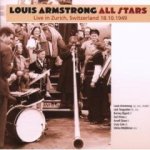 Armstrong's initial influence in the evolution of jazz and his New Orleans roots are inextricably linked. Ragtime was falling out of favor as Armstrong emerged and tinkered with the ragtime rhythm, emphasized swing, and most importantly, moved the needle in the direction solo improvisation. His malleability and suppleness allowed him to coalesce elements of marching music, African rhythmic technique and a variety of genres, with his own inventiveness.
Armstrong's initial influence in the evolution of jazz and his New Orleans roots are inextricably linked. Ragtime was falling out of favor as Armstrong emerged and tinkered with the ragtime rhythm, emphasized swing, and most importantly, moved the needle in the direction solo improvisation. His malleability and suppleness allowed him to coalesce elements of marching music, African rhythmic technique and a variety of genres, with his own inventiveness. Trombonist Jack Teagarden, pianist Earl Hines and clarinetist Barney Bigard are the more recognizable names joining the Louis Armstrong All Stars: Live in Zurich, Switzerland 18.10.1949 (Montreaux Jazz Label, 2008). Captured at a Swiss radio broadcast, Armstrong's septet sounds inspired by the animated audience reaction.
It's Armstrong's show throughout as he reaches for distant heights on his instrument, and finds them. His vocalizing—here in his pre-pop star era—is more humane and earthy on tracks such as "Black and Blue." Teagarden contributes two vocals on classic New Orleans standards "Do You Know What It Means (To Miss New Orleans)?" and "Basin Street Blues." Hines cuts loose on "Body and Soul" as he gets caught up in the enthusiasm of the audience. It's an exceptional band in a perfect setting.
< Previous
Just Funkin' Around
Comments
Tags
Under the Radar
Karl Ackermann
Louis Armstrong
King Oliver
Pete Fountain
Sidney Bechet
Bix Beiderbecke
Kid Ory
George Lewis
Dizzy Gillespie
duke ellington
McCoy Tyner
B.B. King
Jelly Roll Morton
Jack Teagarden
Earl Hines
Barney Bigard
For the Love of Jazz
 All About Jazz has been a pillar of jazz since 1995, championing it as an art form and, more importantly, supporting the musicians who create it. Our enduring commitment has made "AAJ" one of the most culturally important websites of its kind, read by hundreds of thousands of fans, musicians and industry figures every month.
All About Jazz has been a pillar of jazz since 1995, championing it as an art form and, more importantly, supporting the musicians who create it. Our enduring commitment has made "AAJ" one of the most culturally important websites of its kind, read by hundreds of thousands of fans, musicians and industry figures every month.






